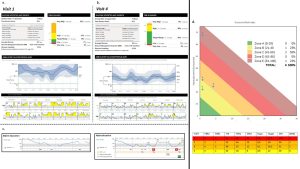Background: Phenylketonuria (PKU) is an inherited congenital disorder characterized by deficiency or reduced activity of the enzyme phenylalanine hydroxylase (PAH). If not adequately managed, PKU leads to severe complications resulting from the toxic accumulation of phenylalanine (Phe). PKU may coexist with several diseases, even with Type 1 Diabetes (T1D), although this combination is rare and scientific reports are limited. Case presentation: a 27-year-old young adult with PKU was recently diagnosed with T1D. The patient, in transition from a paediatric setting to our adult care center, was started on intensive insulin therapy with a basal bolus strategy and on continuous glucose monitoring (CGM) using an intermittent scanning system (isCGM). Following T1D diagnosis, the patient abandoned the specific medical-nutritional therapy (MNT) for PKU, characterized by low Protein/Phe food with a high glycaemic index. During visit 1, data from the isCGM (Fig. 1a) showed constant hyperglycaemia (especially nocturnal) and some hypoglycaemic events before lunch. In addition, Phe levels were persistently elevated. Before referring the patient to MNT for PKU, we intensified insulin therapy and educated the patient on management of hypo- and hyperglycaemia, on the proper use of the isCGM system, by increasing frequency of daily scans and declaring meals and insulin units (Fig. 1c). Finally, implementing carbohydrate counting prevented worsening of glycaemic control at reintroduction of MNT for PKU. During visit 4 isCGM data showed improvement in time in range, time above range (especially Level 2), without worsening time below range (Fig. 1b). A significant improvement in glycated haemoglobin was observed during the 18 weeks follow-up (HbA1c 7.8% vs 11.5% at baseline). Additionally, Glycaemic Risk Index shifted from the E zone to the B zone, characterized by lower glycaemic risk (Fig. 1d). Conclusions: The coexistence of PKU and T1D requires special attention because of the complex interactions between the dietary and pharmacological regimens required to manage both conditions. Glucose profile monitoring through a CGM device is an essential tool to optimize glucose control and disease management.


